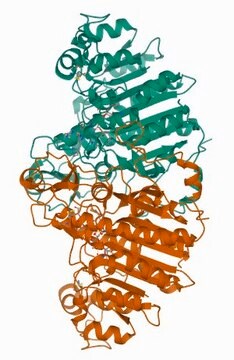おすすめの製品
product name
FLAG®ペプチド, lyophilized powder
アッセイ
≥85% (HPLC)
品質水準
形状
lyophilized powder
分子量
1012.97 Da
輸送温度
wet ice
保管温度
2-8°C
SMILES記法
NCCCC[C@H](NC(=O)[C@H](CC(O)=O)NC(=O)[C@H](CC(O)=O)NC(=O)[C@H](CC(O)=O)NC(=O)[C@H](CC(O)=O)NC(=O)[C@H](CCCCN)NC(=O)[C@H](Cc1ccc(O)cc1)NC(=O)[C@@H](N)CC(O)=O)C(O)=O
InChI
1S/C41H60N10O20/c42-11-3-1-5-22(45-36(65)24(13-19-7-9-20(52)10-8-19)47-34(63)21(44)14-29(53)54)35(64)48-26(16-31(57)58)38(67)50-28(18-33(61)62)40(69)51-27(17-32(59)60)39(68)49-25(15-30(55)56)37(66)46-23(41(70)71)6-2-4-12-43/h7-10,21-28,52H,1-6,11-18,42-44H2,(H,45,65)(H,46,66)(H,47,63)(H,48,64)(H,49,68)(H,50,67)(H,51,69)(H,53,54)(H,55,56)(H,57,58)(H,59,60)(H,61,62)(H,70,71)/t21-,22-,23-,24-,25-,26-,27-,28-/m0/s1
InChI Key
XZWYTXMRWQJBGX-VXBMVYAYSA-N
詳細
アプリケーション
製品の詳細につきましては、FLAG®アプリケーションポータルをご覧ください。
調製ノート
法的情報
保管分類コード
11 - Combustible Solids
WGK
WGK 3
引火点(°F)
Not applicable
引火点(℃)
Not applicable
個人用保護具 (PPE)
Eyeshields, Gloves, type N95 (US)
適用法令
試験研究用途を考慮した関連法令を主に挙げております。化学物質以外については、一部の情報のみ提供しています。 製品を安全かつ合法的に使用することは、使用者の義務です。最新情報により修正される場合があります。WEBの反映には時間を要することがあるため、適宜SDSをご参照ください。
Jan Code
F3290-25MG-PW:
F3290-25MG:
F3290-4MG-PW:
F3290-4MG:
F3290PROC:
F3290-4MG-KC:
F3290-BULK-N:
F3290-PH:
F3290-BULK:
F3290-VAR:
試験成績書(COA)
製品のロット番号・バッチ番号を入力して、試験成績書(COA) を検索できます。ロット番号・バッチ番号は、製品ラベルに「Lot」または「Batch」に続いて記載されています。
この製品を見ている人はこちらもチェック
関連コンテンツ
イオン交換、サイズ排除、タンパク質アフィニティークロマトグラフィーなどの方法を用いた組換えタンパク質精製のためのタンパク質精製技術、試薬、プロトコル
Protein purification techniques, reagents, and protocols for purifying recombinant proteins using methods including, ion-exchange, size-exclusion, and protein affinity chromatography.
Protein expression technologies for expressing recombinant proteins in E. coli, insect, yeast, and mammalian expression systems for fundamental research and the support of therapeutics and vaccine production.
基礎研究および治療法とワクチン生産のサポートのための大腸菌、昆虫、酵母、および哺乳類の発現システムで組換えタンパク質を発現させるためのタンパク質発現技術。
ライフサイエンス、有機合成、材料科学、クロマトグラフィー、分析など、あらゆる分野の研究に経験のあるメンバーがおります。.
製品に関するお問い合わせはこちら(テクニカルサービス)











